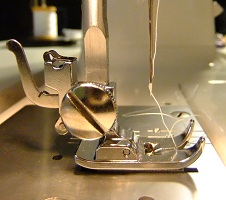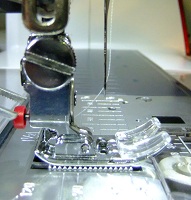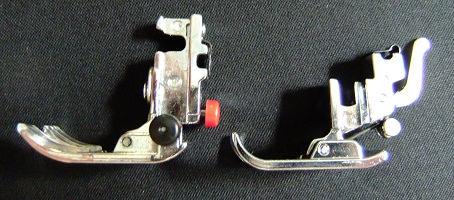Piecing on the Janome HD 1000
I’m posting this late today because I’ve had to basically totally remake the Leah Day Quilt Shop after a software glitch earlier this week. It’s been stressful and tiring, but I think everything is back up and working fine. I have redesigned the store a bit, so definitely click here to check it out and let me know what you think!
Today I’m finally ready to get quilting and piecing on the Janome HD 1000! I have to say, the more I play with this machine, the more I like it. I’m not being biased or anything here, I just enjoy stitching on this machine and find it very easy to use.
In my last post, I mentioned how this machine really only has a center needle position. I was correct in the comments by BB (thank you!) who mentioned that the narrowest zigzag setting will often move the needle position to one side or the other.
I tried this out and yes, if you put the machine in stitch mode “C” on the narrowest zigzag, the needle will pop over to the far left side. Still, even on the far left side, the needle is just not in the right position to stitch an accurate 1/4″ seam allowance with any of the feet the machine came with.
First off, let’s talk about the word GENERIC.
Many quilters seem to think this is a dirty word. Even I had a bias against it for a long time, and it was only after dealing with my Juki that I began to love generic feet with a passion.
So why do some quilters think generic feet stink?
Allow me to share my own personal history of bias against this word…
I can well remember purchasing my first Bernina (sorry Bernina owners and dealers, but I’m going to pick on you a bit!)
I bought my first Bernina machine used, and at $500, I was suffering from serious sticker shock. Thinking back now, I think that was the most expensive THING I’d ever bought up to that point (minus my useless college education).
But I can still remember asking the store owner about a Walking Foot, also called an Even Feed foot because the machine hadn’t come with one. The dealer showed me the Official Bernina Walking Foot which retailed for $150 at the time! Whoa! That’s ridiculous!
And when I balked at the price, the owner said something like “Oh, well, you could go with a generic foot, but they aren’t guaranteed if they break and won’t work as well…” All this said in a tone of voice that implies that generic feet are bad, bad, bad!
So I left the store and came back a few months later and bought the official, name brand, guaranteed, embossed in gold Bernina walking foot for $150.00.
And when I upgraded to a newer Bernina a few years later and my old walking foot would no longer fit, I purchased a second official, name brand, guaranteed walking foot for $170!
Why was I so convinced the name brand was better? I’m not sure, but I think it had a lot to do with how that store owner made me feel. She made me feel cheap and not as good a quilter – not as smart or as dedicated because I couldn’t afford the name brand foot.
And she filled my head with the idea that only the company can design good feet for their machines. Trust in the company and all your problems will be solved….
Fast forward a few years when I bought my Juki TL 98 QE, a machine with possibly the worst designed feet in existence. Sharon Shamber makes a special foot for this machine, which I tried and liked, but ultimately I had to break the darning foot open in order for it to work properly and give me the visibility I needed.
Before breaking it, I searched high and low for a better foot from the company. Surely Juki has to have more choice for their high shank machines?! Surely they wouldn’t only have these bad feet? Surely they would realize when quilters are making or breaking their feet, there is a problem with the design?!
Trust in the company and all your problems will be solved... Yeah right! My trust for brand named everything flew out the window with that experience and I began looking exclusively for generic feet to do the job.
Generic feet have quite a lot going for them:
- Mass produced so they are much cheaper than official brand named feet.
- Designed to fit standard shank sewing machines: High shank, low shank, and singer slant shank. All you have to know is what shank your machine is and then you’re in business.
- Often the exact same design and quality as the official name branded feet.
- Because they’re so much cheaper, you worry less when you have to modify them!
Why spend more for exactly the same thing from the company? Seriously, why?
I’m not doing it anymore! I received loads of emails from quilters wondering what the foot was that I’m using on the Janome Horizon for piecing.
From now on, I’m using this generic Patchwork foot in the snap on style. It works just as good as the other foot I was using, costs half the price, and the quality is exactly the same!
So the Janome HD 1000 is a low shank machine. How do I know? Check out this photo:

This is the side of the presser foot on the Janome HD 1000. See where the screw is located? Very low down on the foot. Compare with this photo:

This is the Janome Horizon’s presser foot. See how high the screw is on this machine? This is a high shank machine.
While it might be tricky to tell from these photos, this one definitely shows the difference:

Low shank feet are literally that – low. The notch for the screw to attach the foot to the machine is very close to the base of the foot. High shank feet are the opposite, the hole for the screw is far away from the base of the foot.
Now of course Singer has to go and make things difficult by also having a slant shank option, and another machine brand (Kenmore?) has a Super High Shank option too. And of course Bernina feet are not compatible with anything other than Bernina feet (unless you use a generic adapter), and I think Viking can be pretty finicky too.
But for the most part, MOST machines can be identified as either High shank or Low Shank and I’d say most of the machines I’ll be reviewing for under $500 will be low shank.
I’ve gotten pretty good at identifying which machines are which, so if you’re curious to know what shank your machine is, post a photo of it on the group flickr account and I’ll take a look.
Now as for the machine! As I said earlier, I’m really loving this little machine!
While Josh is hoping I’ll sell each machine in the review before buying the next one, I don’t think I can part with this one. It takes the same bobbins as the Horizon so I think it’s going to make a great little workshop machine, something I can tote around town with no problem.
Of course being used to features like a knee lifter, higher powered lights, and an automatic needle down means that sometimes I make mistakes on this machine simply because I’m used to those features.
Just in case you don’t know what these things are, here’s a quick definition:
- Knee lifter – A bar that comes out from the front of the machine which can lift the presser foot. You operate this with your knee so you don’t have to take your hands off of your project. This is VERY useful for piecing and applique.
- Higher powered lights – Why aren’t LED lights STANDARD??? And why don’t ALL machines have a second light to the RIGHT of the needle? That is where we do the most of our sewing!
- Auto needle down – Causes your machine to always end with the needle in the down position – VERY convenient when free motion quilting because you can easily stitch to a line, stop, rotate the quilt, then start again without having to take your hands off the quilt.
But the more I play with it, the more I realize just how LITTLE these features really matter.
The lighting can be fixed with bigger lights around the table, and I can always use my hands to lift the presser foot slightly or turn the hand wheel to put the needle down in the machine.
So the real question is – is a knee lifter, LED lights, and auto needle down really worth $1000 – $2500?
That’s a hard question to answer. It’s almost like trying to answer the question – Are automatic door locks and windows really worth the $1000 extra you pay for them on your car? Is the icemaker in your freezer really worth the extra $500 tacked on to your refrigerator?
All of these things make life more convenient, but do they actually make it easier or faster to get our sewing projects done?
I’ll let you ponder over that one for a bit!
Let’s go quilt,
Leah Day

maybe you could keep a running list of high/low shank machines somewhere on your website? (ie, once you've identified it)
Hi Michelle – I'm working on an area of my website to house all the sewing machine reviews. If I can find the information, or if the reviewer knew what the machine was, then that information will be posted with each review. It's a lot to get together and is requiring a lot of research which is why it's taking forever to get started!
Once it's up it will be much easier to update with more reviews and opinions of more quilters who own each machine. I'm hoping this will help everyone find really good machines for less money and to find feet that work properly too!
Cheers,
Leah
I really love your championship of affordable tools. Sewing machines are like other art supplies: they make some difference, but the real difference lies in the abilities of the artist, not the tools. Very high prices on art tools are a kind of juju – learning is scary, buying is easy, so why not pretend the value lies in the price? I also loved your jab at your college education (I feel the same way!). One learns to be an artist by making art, and that costs more time and attention than money.
If I had the space, I'd explore free motion quilting on a treadle machine. These are available used at low prices, and are standard in countries where electricity is unreliable, like India. All-mechanical, no electric bills, and last forever – seems like the ultimate affordable tool, and a great stage for the artist's skill. Will you be reviewing a treadle machine?
Unrelated to this post, but I just saw your blog included in the Quilter's Home magazine list of 55 best blogs – Congrats!
I have a Brother SE 400. It has the multi position needle, a good quilting foot, low shank, and the needle up or down setting. For less than $400 I really like it. Jona in MS
Leah – you are too funny when you get a roll about something – LOVE IT! I just want to say something that I love about my Janome – all the feet from my Elna quilter's dream (a 13 yr old machine) fit my Horizon. I've never "broken" a foot – but my cat has "lost" a foot on me! So its nice to know that I can just go to my other machine and grab a fav foot.
Thanks so much for posting about your dealer's behavior – Quilters really need to start empowering themselves against salespeople like these! Geesh!! Why can't quilting and sewing be all warm and fuzzy???
I'm the owner of an older Bernina with a pretty good supply of feet that came with the machine, many of which I really don't use. When I took up quilting a few years ago, I found I was missing a few that would make quilting easier, although luckily I did have a walking foot. After buying a genuine free motion foot, I started looking at generics and bought a few of them from a dealer on ebay. They look exactly the same & perform perfectly in my estimation. So I agree, go for it at about 1/4 of the cost.
Thank you for sharing your knowledge of FMQ. I've learned soooo much from you and your site. I have been a Janome user for a long time and hated their quarter inch foot almost right away. I've been using the Little Foot with success, but now I want to try your generic foot. I didn't know such a foot was out there. I guess we're never too old to learn. As a footnote, can you post more sometime about the bobbin washers? I don't understand the thoery behind their use.
Hi;
Thanks for such a complete and enjoyable post on generic feet. I'm digging into quilting sewing machines, and was pleased to learn that you don't always have to buy feet from the same manufacturer and the machine.
cheers,
JD
http://quiltingmachinesforsale.com
Great post with lots of good info!! Thanks for sharing!
Paulette
Have you used the generic piecing foot on your Horizon? Does it work well? I'm assuming the snap on foot would fit?
Thanks for all your great info!
Constance – Yep, the snap on foot works great on the Horizon. I actually prefer it to the other foot I was using because it's easier to see.
Cheers,
Leah
Leah, how did you like the 1000 for free motion quilting? Would love to hear how it stacks up against the Horizon in that department.
Thanks for taking the time to do your wonderful reviews!